Exploring PRINCE2 Methodology's Impact on Project Success Rate
VerifiedAdded on 2023/06/12
|10
|2322
|149
Literature Review
AI Summary
This literature review explores the PRINCE2 (Projects IN Controlled Environments) methodology and its impact on project management success. It delves into the seven principles, themes, and processes of PRINCE2, highlighting its advantages and disadvantages. The review emphasizes the importance of business justification, learning from experience, defined roles, and managing project stages. It also covers the seven themes, including business case, organization, quality, risks, plans, change, and progress. The seven processes, such as starting up the project, initiating the project, directing the project, controlling stages, managing delivery, managing stage boundaries, and closing the project, are also discussed. The review concludes that while PRINCE2 offers a structured and predictable approach, it may lack the flexibility required for modern project management, particularly in the software industry. Desklib provides access to this and other solved assignments for students.
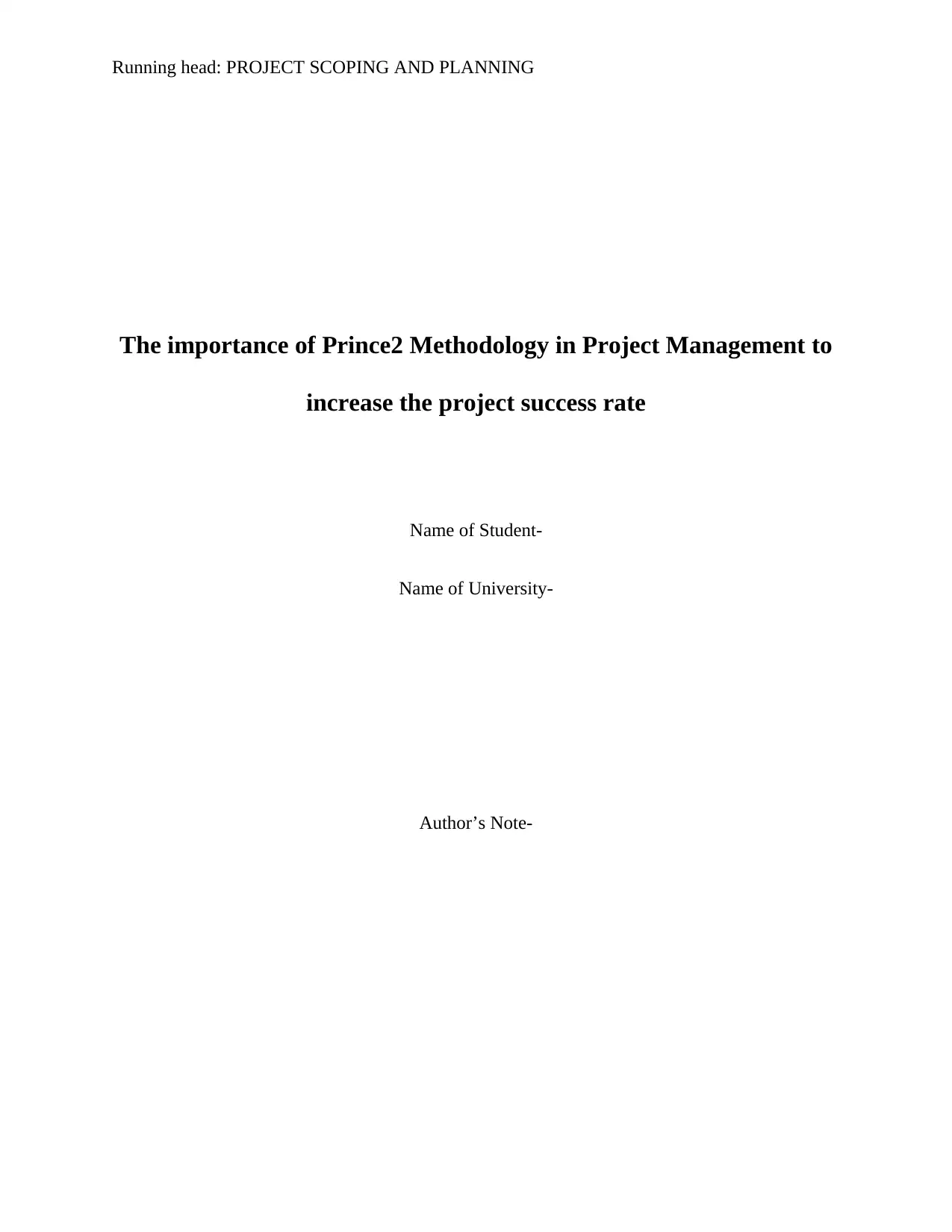
Running head: PROJECT SCOPING AND PLANNING
The importance of Prince2 Methodology in Project Management to
increase the project success rate
Name of Student-
Name of University-
Author’s Note-
The importance of Prince2 Methodology in Project Management to
increase the project success rate
Name of Student-
Name of University-
Author’s Note-
Paraphrase This Document
Need a fresh take? Get an instant paraphrase of this document with our AI Paraphraser
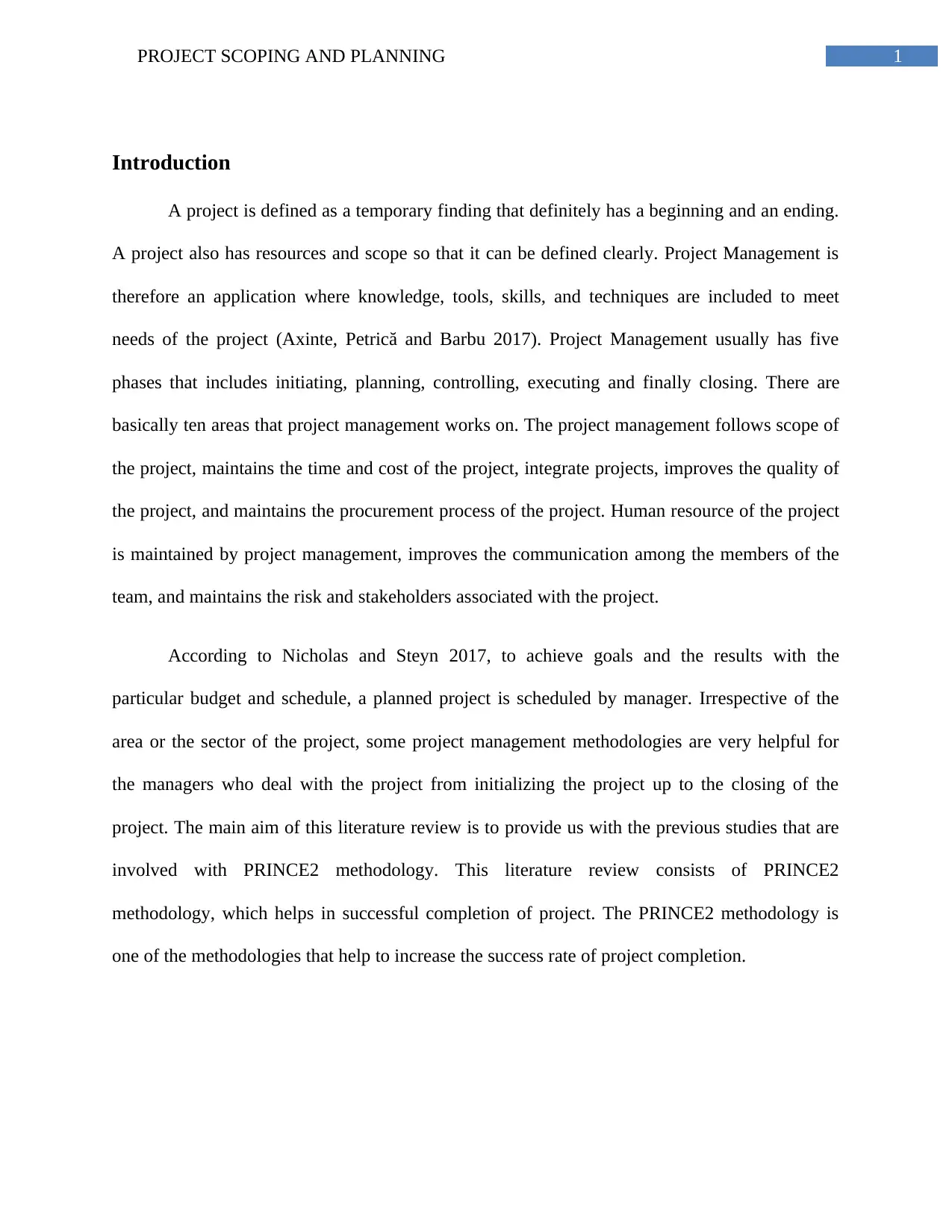
1PROJECT SCOPING AND PLANNING
Introduction
A project is defined as a temporary finding that definitely has a beginning and an ending.
A project also has resources and scope so that it can be defined clearly. Project Management is
therefore an application where knowledge, tools, skills, and techniques are included to meet
needs of the project (Axinte, Petrică and Barbu 2017). Project Management usually has five
phases that includes initiating, planning, controlling, executing and finally closing. There are
basically ten areas that project management works on. The project management follows scope of
the project, maintains the time and cost of the project, integrate projects, improves the quality of
the project, and maintains the procurement process of the project. Human resource of the project
is maintained by project management, improves the communication among the members of the
team, and maintains the risk and stakeholders associated with the project.
According to Nicholas and Steyn 2017, to achieve goals and the results with the
particular budget and schedule, a planned project is scheduled by manager. Irrespective of the
area or the sector of the project, some project management methodologies are very helpful for
the managers who deal with the project from initializing the project up to the closing of the
project. The main aim of this literature review is to provide us with the previous studies that are
involved with PRINCE2 methodology. This literature review consists of PRINCE2
methodology, which helps in successful completion of project. The PRINCE2 methodology is
one of the methodologies that help to increase the success rate of project completion.
Introduction
A project is defined as a temporary finding that definitely has a beginning and an ending.
A project also has resources and scope so that it can be defined clearly. Project Management is
therefore an application where knowledge, tools, skills, and techniques are included to meet
needs of the project (Axinte, Petrică and Barbu 2017). Project Management usually has five
phases that includes initiating, planning, controlling, executing and finally closing. There are
basically ten areas that project management works on. The project management follows scope of
the project, maintains the time and cost of the project, integrate projects, improves the quality of
the project, and maintains the procurement process of the project. Human resource of the project
is maintained by project management, improves the communication among the members of the
team, and maintains the risk and stakeholders associated with the project.
According to Nicholas and Steyn 2017, to achieve goals and the results with the
particular budget and schedule, a planned project is scheduled by manager. Irrespective of the
area or the sector of the project, some project management methodologies are very helpful for
the managers who deal with the project from initializing the project up to the closing of the
project. The main aim of this literature review is to provide us with the previous studies that are
involved with PRINCE2 methodology. This literature review consists of PRINCE2
methodology, which helps in successful completion of project. The PRINCE2 methodology is
one of the methodologies that help to increase the success rate of project completion.
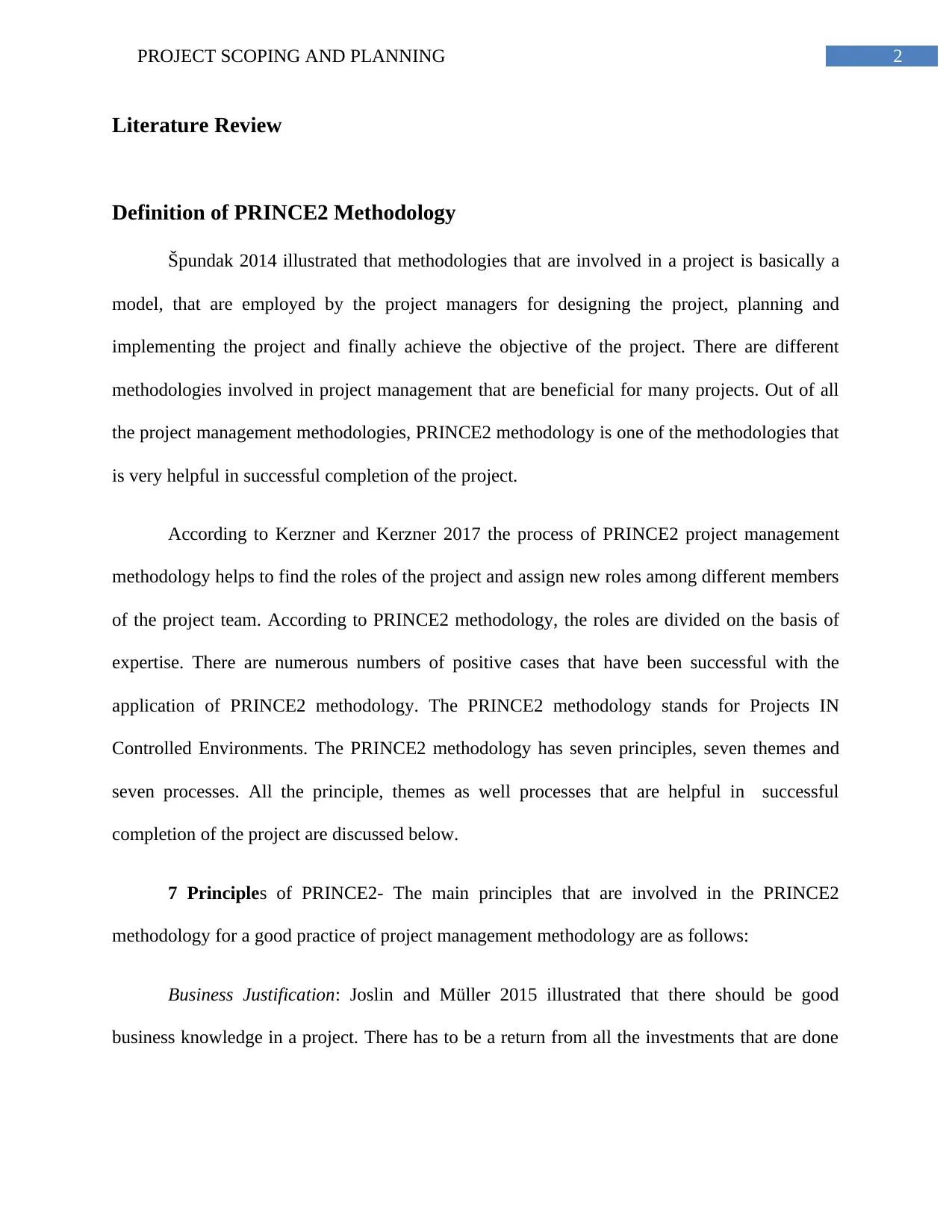
2PROJECT SCOPING AND PLANNING
Literature Review
Definition of PRINCE2 Methodology
Špundak 2014 illustrated that methodologies that are involved in a project is basically a
model, that are employed by the project managers for designing the project, planning and
implementing the project and finally achieve the objective of the project. There are different
methodologies involved in project management that are beneficial for many projects. Out of all
the project management methodologies, PRINCE2 methodology is one of the methodologies that
is very helpful in successful completion of the project.
According to Kerzner and Kerzner 2017 the process of PRINCE2 project management
methodology helps to find the roles of the project and assign new roles among different members
of the project team. According to PRINCE2 methodology, the roles are divided on the basis of
expertise. There are numerous numbers of positive cases that have been successful with the
application of PRINCE2 methodology. The PRINCE2 methodology stands for Projects IN
Controlled Environments. The PRINCE2 methodology has seven principles, seven themes and
seven processes. All the principle, themes as well processes that are helpful in successful
completion of the project are discussed below.
7 Principles of PRINCE2- The main principles that are involved in the PRINCE2
methodology for a good practice of project management methodology are as follows:
Business Justification: Joslin and Müller 2015 illustrated that there should be good
business knowledge in a project. There has to be a return from all the investments that are done
Literature Review
Definition of PRINCE2 Methodology
Špundak 2014 illustrated that methodologies that are involved in a project is basically a
model, that are employed by the project managers for designing the project, planning and
implementing the project and finally achieve the objective of the project. There are different
methodologies involved in project management that are beneficial for many projects. Out of all
the project management methodologies, PRINCE2 methodology is one of the methodologies that
is very helpful in successful completion of the project.
According to Kerzner and Kerzner 2017 the process of PRINCE2 project management
methodology helps to find the roles of the project and assign new roles among different members
of the project team. According to PRINCE2 methodology, the roles are divided on the basis of
expertise. There are numerous numbers of positive cases that have been successful with the
application of PRINCE2 methodology. The PRINCE2 methodology stands for Projects IN
Controlled Environments. The PRINCE2 methodology has seven principles, seven themes and
seven processes. All the principle, themes as well processes that are helpful in successful
completion of the project are discussed below.
7 Principles of PRINCE2- The main principles that are involved in the PRINCE2
methodology for a good practice of project management methodology are as follows:
Business Justification: Joslin and Müller 2015 illustrated that there should be good
business knowledge in a project. There has to be a return from all the investments that are done
⊘ This is a preview!⊘
Do you want full access?
Subscribe today to unlock all pages.

Trusted by 1+ million students worldwide
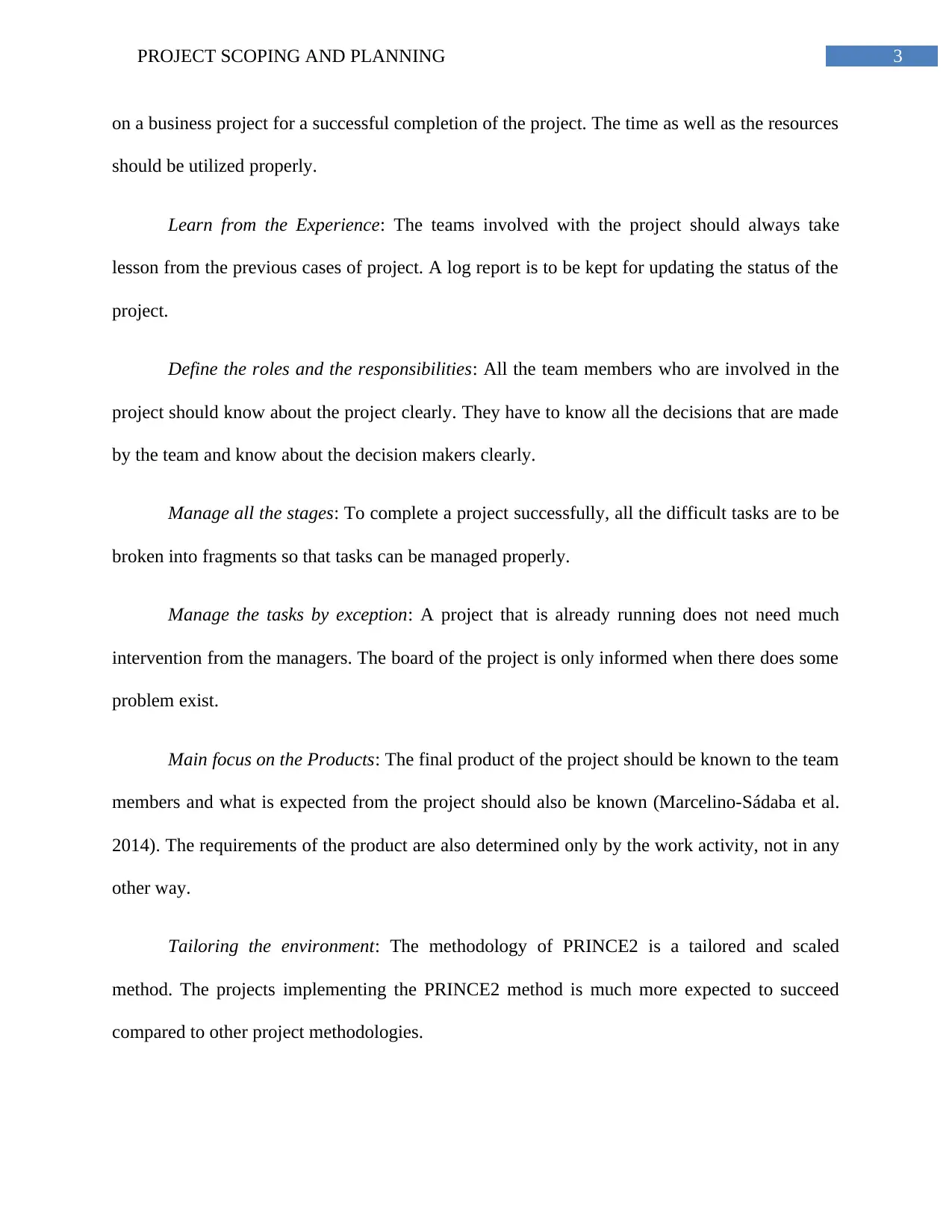
3PROJECT SCOPING AND PLANNING
on a business project for a successful completion of the project. The time as well as the resources
should be utilized properly.
Learn from the Experience: The teams involved with the project should always take
lesson from the previous cases of project. A log report is to be kept for updating the status of the
project.
Define the roles and the responsibilities: All the team members who are involved in the
project should know about the project clearly. They have to know all the decisions that are made
by the team and know about the decision makers clearly.
Manage all the stages: To complete a project successfully, all the difficult tasks are to be
broken into fragments so that tasks can be managed properly.
Manage the tasks by exception: A project that is already running does not need much
intervention from the managers. The board of the project is only informed when there does some
problem exist.
Main focus on the Products: The final product of the project should be known to the team
members and what is expected from the project should also be known (Marcelino-Sádaba et al.
2014). The requirements of the product are also determined only by the work activity, not in any
other way.
Tailoring the environment: The methodology of PRINCE2 is a tailored and scaled
method. The projects implementing the PRINCE2 method is much more expected to succeed
compared to other project methodologies.
on a business project for a successful completion of the project. The time as well as the resources
should be utilized properly.
Learn from the Experience: The teams involved with the project should always take
lesson from the previous cases of project. A log report is to be kept for updating the status of the
project.
Define the roles and the responsibilities: All the team members who are involved in the
project should know about the project clearly. They have to know all the decisions that are made
by the team and know about the decision makers clearly.
Manage all the stages: To complete a project successfully, all the difficult tasks are to be
broken into fragments so that tasks can be managed properly.
Manage the tasks by exception: A project that is already running does not need much
intervention from the managers. The board of the project is only informed when there does some
problem exist.
Main focus on the Products: The final product of the project should be known to the team
members and what is expected from the project should also be known (Marcelino-Sádaba et al.
2014). The requirements of the product are also determined only by the work activity, not in any
other way.
Tailoring the environment: The methodology of PRINCE2 is a tailored and scaled
method. The projects implementing the PRINCE2 method is much more expected to succeed
compared to other project methodologies.
Paraphrase This Document
Need a fresh take? Get an instant paraphrase of this document with our AI Paraphraser
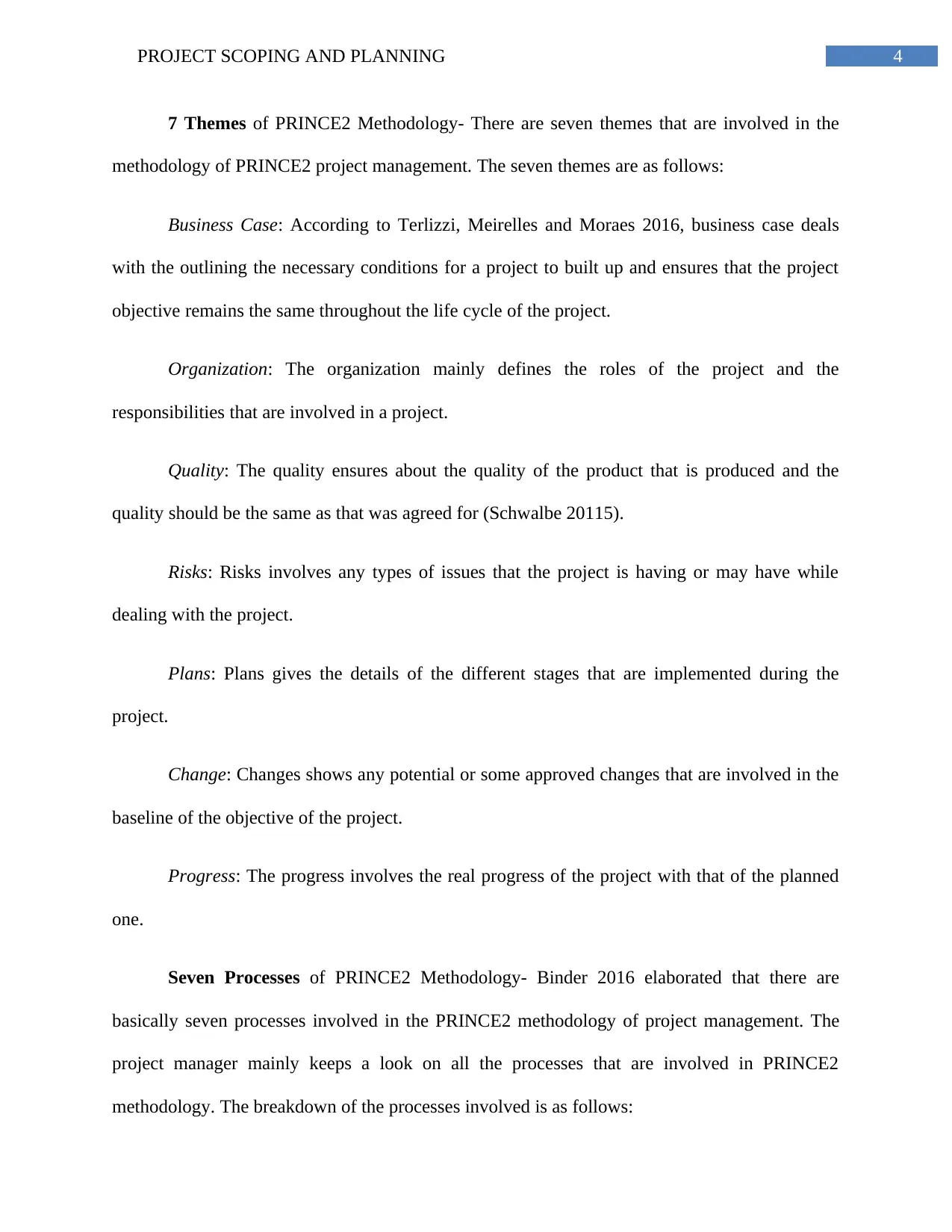
4PROJECT SCOPING AND PLANNING
7 Themes of PRINCE2 Methodology- There are seven themes that are involved in the
methodology of PRINCE2 project management. The seven themes are as follows:
Business Case: According to Terlizzi, Meirelles and Moraes 2016, business case deals
with the outlining the necessary conditions for a project to built up and ensures that the project
objective remains the same throughout the life cycle of the project.
Organization: The organization mainly defines the roles of the project and the
responsibilities that are involved in a project.
Quality: The quality ensures about the quality of the product that is produced and the
quality should be the same as that was agreed for (Schwalbe 20115).
Risks: Risks involves any types of issues that the project is having or may have while
dealing with the project.
Plans: Plans gives the details of the different stages that are implemented during the
project.
Change: Changes shows any potential or some approved changes that are involved in the
baseline of the objective of the project.
Progress: The progress involves the real progress of the project with that of the planned
one.
Seven Processes of PRINCE2 Methodology- Binder 2016 elaborated that there are
basically seven processes involved in the PRINCE2 methodology of project management. The
project manager mainly keeps a look on all the processes that are involved in PRINCE2
methodology. The breakdown of the processes involved is as follows:
7 Themes of PRINCE2 Methodology- There are seven themes that are involved in the
methodology of PRINCE2 project management. The seven themes are as follows:
Business Case: According to Terlizzi, Meirelles and Moraes 2016, business case deals
with the outlining the necessary conditions for a project to built up and ensures that the project
objective remains the same throughout the life cycle of the project.
Organization: The organization mainly defines the roles of the project and the
responsibilities that are involved in a project.
Quality: The quality ensures about the quality of the product that is produced and the
quality should be the same as that was agreed for (Schwalbe 20115).
Risks: Risks involves any types of issues that the project is having or may have while
dealing with the project.
Plans: Plans gives the details of the different stages that are implemented during the
project.
Change: Changes shows any potential or some approved changes that are involved in the
baseline of the objective of the project.
Progress: The progress involves the real progress of the project with that of the planned
one.
Seven Processes of PRINCE2 Methodology- Binder 2016 elaborated that there are
basically seven processes involved in the PRINCE2 methodology of project management. The
project manager mainly keeps a look on all the processes that are involved in PRINCE2
methodology. The breakdown of the processes involved is as follows:
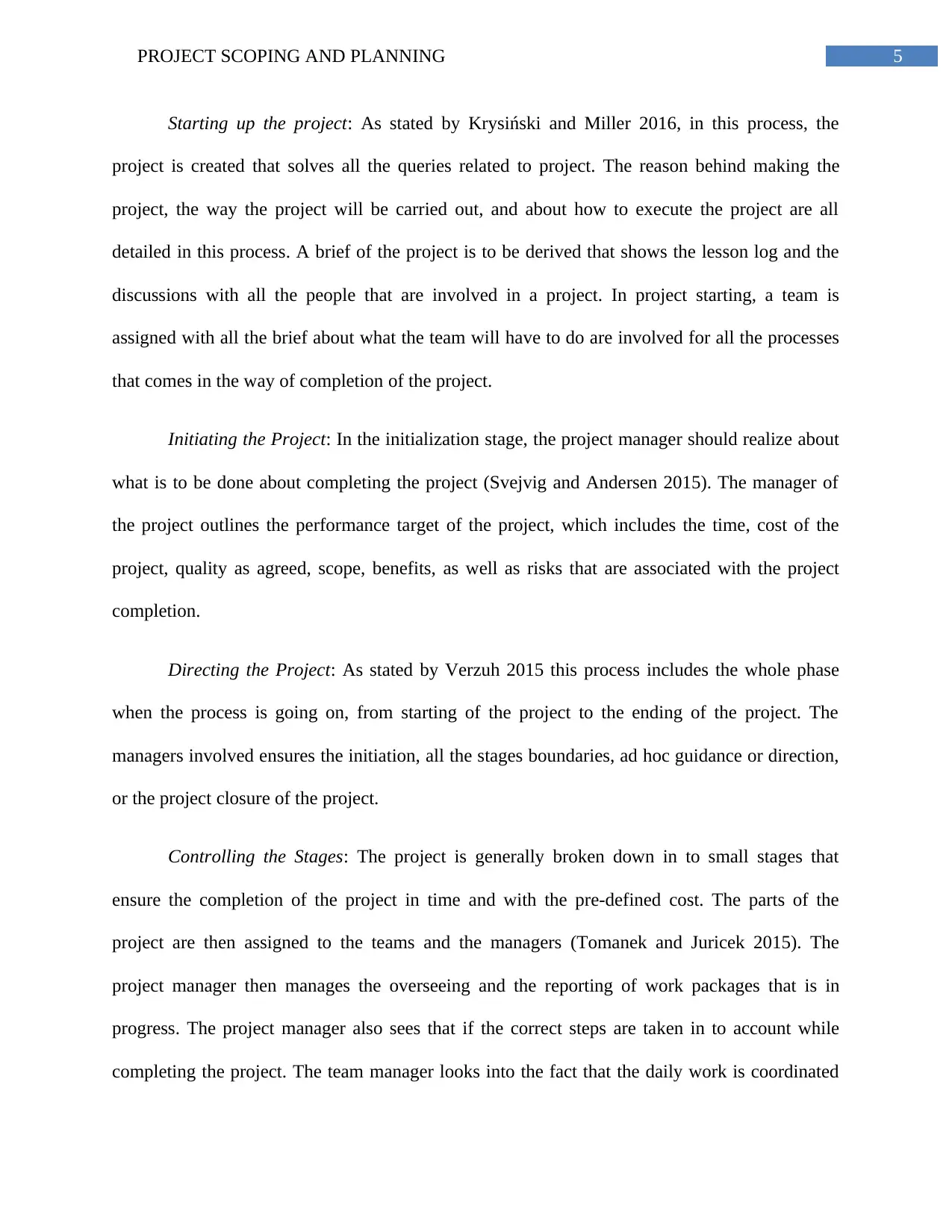
5PROJECT SCOPING AND PLANNING
Starting up the project: As stated by Krysiński and Miller 2016, in this process, the
project is created that solves all the queries related to project. The reason behind making the
project, the way the project will be carried out, and about how to execute the project are all
detailed in this process. A brief of the project is to be derived that shows the lesson log and the
discussions with all the people that are involved in a project. In project starting, a team is
assigned with all the brief about what the team will have to do are involved for all the processes
that comes in the way of completion of the project.
Initiating the Project: In the initialization stage, the project manager should realize about
what is to be done about completing the project (Svejvig and Andersen 2015). The manager of
the project outlines the performance target of the project, which includes the time, cost of the
project, quality as agreed, scope, benefits, as well as risks that are associated with the project
completion.
Directing the Project: As stated by Verzuh 2015 this process includes the whole phase
when the process is going on, from starting of the project to the ending of the project. The
managers involved ensures the initiation, all the stages boundaries, ad hoc guidance or direction,
or the project closure of the project.
Controlling the Stages: The project is generally broken down in to small stages that
ensure the completion of the project in time and with the pre-defined cost. The parts of the
project are then assigned to the teams and the managers (Tomanek and Juricek 2015). The
project manager then manages the overseeing and the reporting of work packages that is in
progress. The project manager also sees that if the correct steps are taken in to account while
completing the project. The team manager looks into the fact that the daily work is coordinated
Starting up the project: As stated by Krysiński and Miller 2016, in this process, the
project is created that solves all the queries related to project. The reason behind making the
project, the way the project will be carried out, and about how to execute the project are all
detailed in this process. A brief of the project is to be derived that shows the lesson log and the
discussions with all the people that are involved in a project. In project starting, a team is
assigned with all the brief about what the team will have to do are involved for all the processes
that comes in the way of completion of the project.
Initiating the Project: In the initialization stage, the project manager should realize about
what is to be done about completing the project (Svejvig and Andersen 2015). The manager of
the project outlines the performance target of the project, which includes the time, cost of the
project, quality as agreed, scope, benefits, as well as risks that are associated with the project
completion.
Directing the Project: As stated by Verzuh 2015 this process includes the whole phase
when the process is going on, from starting of the project to the ending of the project. The
managers involved ensures the initiation, all the stages boundaries, ad hoc guidance or direction,
or the project closure of the project.
Controlling the Stages: The project is generally broken down in to small stages that
ensure the completion of the project in time and with the pre-defined cost. The parts of the
project are then assigned to the teams and the managers (Tomanek and Juricek 2015). The
project manager then manages the overseeing and the reporting of work packages that is in
progress. The project manager also sees that if the correct steps are taken in to account while
completing the project. The team manager looks into the fact that the daily work is coordinated
⊘ This is a preview!⊘
Do you want full access?
Subscribe today to unlock all pages.

Trusted by 1+ million students worldwide
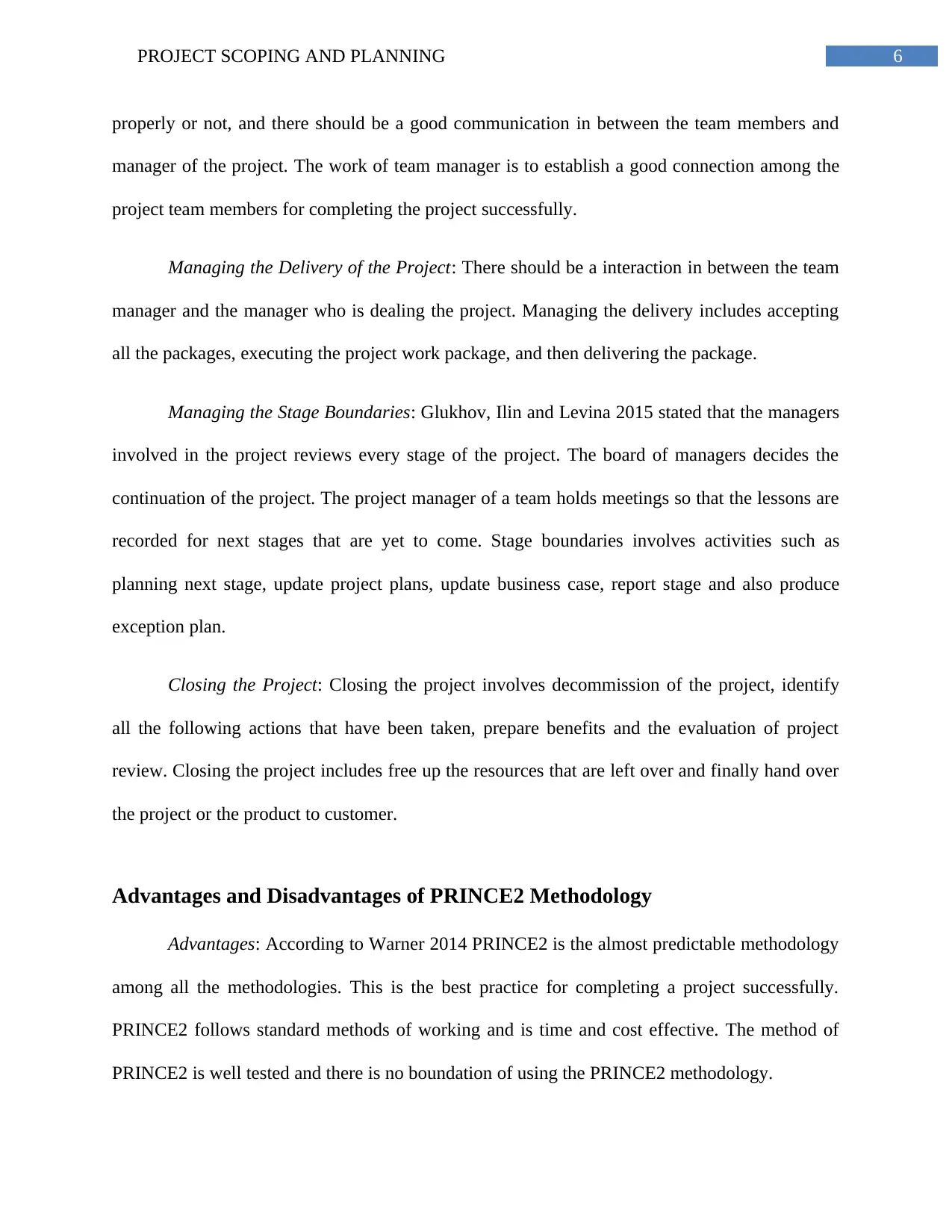
6PROJECT SCOPING AND PLANNING
properly or not, and there should be a good communication in between the team members and
manager of the project. The work of team manager is to establish a good connection among the
project team members for completing the project successfully.
Managing the Delivery of the Project: There should be a interaction in between the team
manager and the manager who is dealing the project. Managing the delivery includes accepting
all the packages, executing the project work package, and then delivering the package.
Managing the Stage Boundaries: Glukhov, Ilin and Levina 2015 stated that the managers
involved in the project reviews every stage of the project. The board of managers decides the
continuation of the project. The project manager of a team holds meetings so that the lessons are
recorded for next stages that are yet to come. Stage boundaries involves activities such as
planning next stage, update project plans, update business case, report stage and also produce
exception plan.
Closing the Project: Closing the project involves decommission of the project, identify
all the following actions that have been taken, prepare benefits and the evaluation of project
review. Closing the project includes free up the resources that are left over and finally hand over
the project or the product to customer.
Advantages and Disadvantages of PRINCE2 Methodology
Advantages: According to Warner 2014 PRINCE2 is the almost predictable methodology
among all the methodologies. This is the best practice for completing a project successfully.
PRINCE2 follows standard methods of working and is time and cost effective. The method of
PRINCE2 is well tested and there is no boundation of using the PRINCE2 methodology.
properly or not, and there should be a good communication in between the team members and
manager of the project. The work of team manager is to establish a good connection among the
project team members for completing the project successfully.
Managing the Delivery of the Project: There should be a interaction in between the team
manager and the manager who is dealing the project. Managing the delivery includes accepting
all the packages, executing the project work package, and then delivering the package.
Managing the Stage Boundaries: Glukhov, Ilin and Levina 2015 stated that the managers
involved in the project reviews every stage of the project. The board of managers decides the
continuation of the project. The project manager of a team holds meetings so that the lessons are
recorded for next stages that are yet to come. Stage boundaries involves activities such as
planning next stage, update project plans, update business case, report stage and also produce
exception plan.
Closing the Project: Closing the project involves decommission of the project, identify
all the following actions that have been taken, prepare benefits and the evaluation of project
review. Closing the project includes free up the resources that are left over and finally hand over
the project or the product to customer.
Advantages and Disadvantages of PRINCE2 Methodology
Advantages: According to Warner 2014 PRINCE2 is the almost predictable methodology
among all the methodologies. This is the best practice for completing a project successfully.
PRINCE2 follows standard methods of working and is time and cost effective. The method of
PRINCE2 is well tested and there is no boundation of using the PRINCE2 methodology.
Paraphrase This Document
Need a fresh take? Get an instant paraphrase of this document with our AI Paraphraser
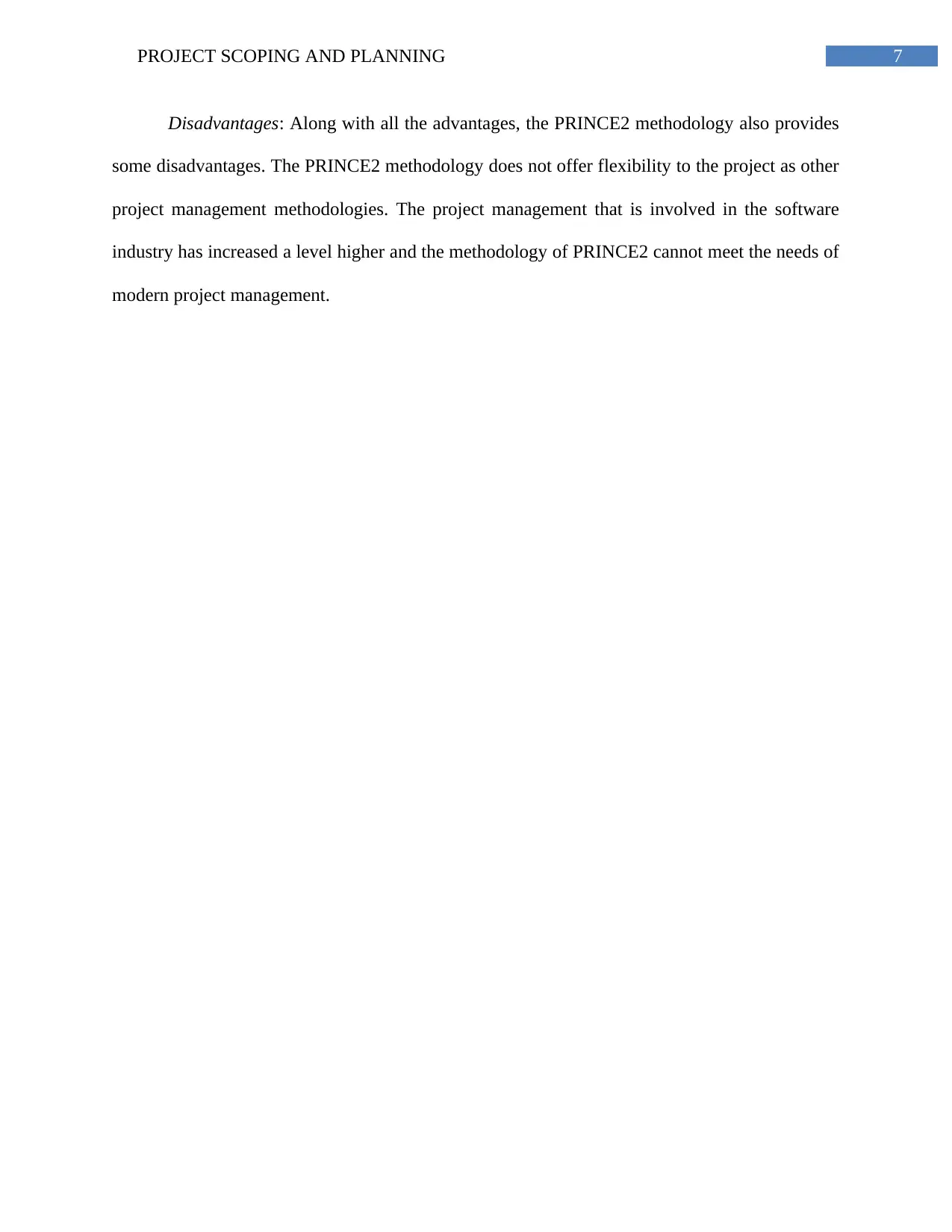
7PROJECT SCOPING AND PLANNING
Disadvantages: Along with all the advantages, the PRINCE2 methodology also provides
some disadvantages. The PRINCE2 methodology does not offer flexibility to the project as other
project management methodologies. The project management that is involved in the software
industry has increased a level higher and the methodology of PRINCE2 cannot meet the needs of
modern project management.
Disadvantages: Along with all the advantages, the PRINCE2 methodology also provides
some disadvantages. The PRINCE2 methodology does not offer flexibility to the project as other
project management methodologies. The project management that is involved in the software
industry has increased a level higher and the methodology of PRINCE2 cannot meet the needs of
modern project management.
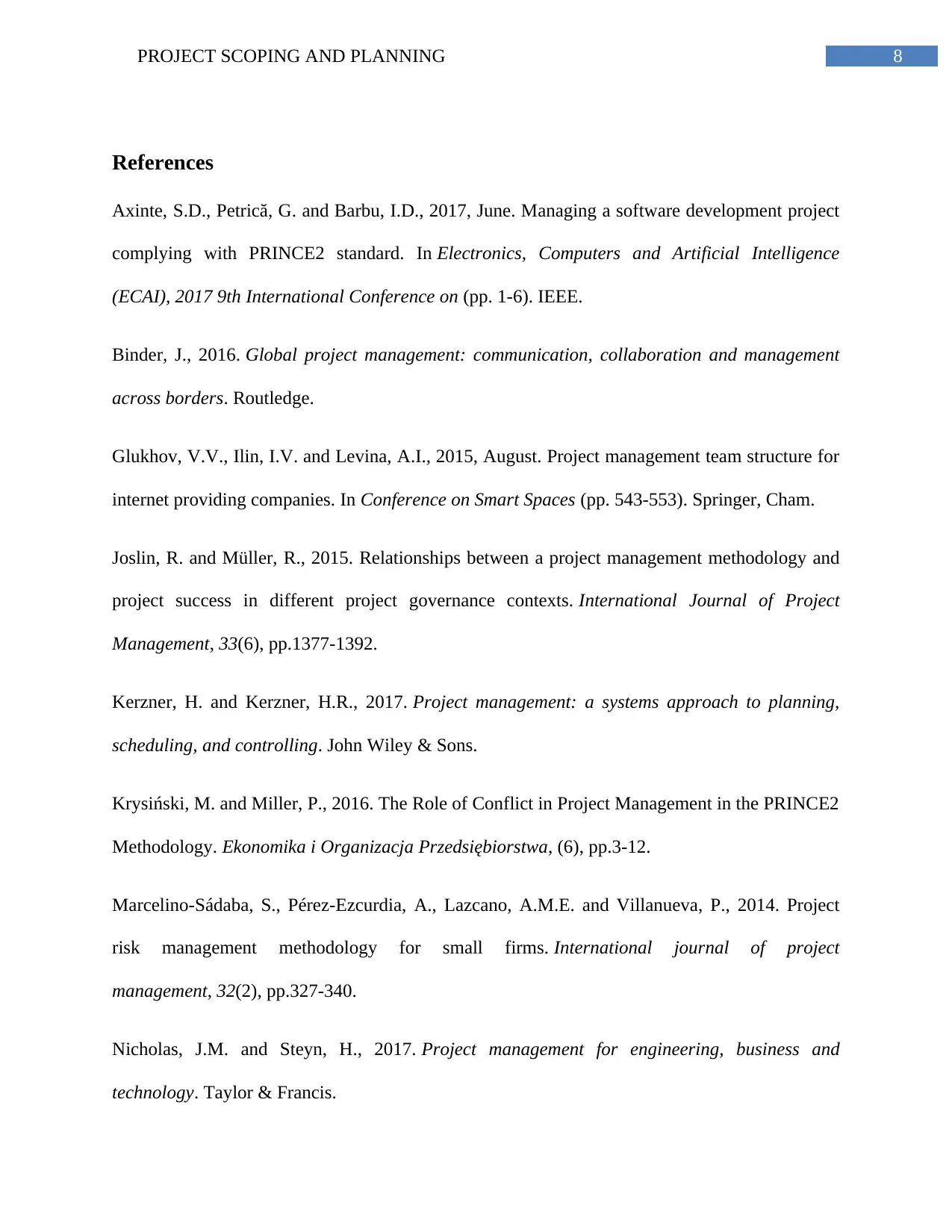
8PROJECT SCOPING AND PLANNING
References
Axinte, S.D., Petrică, G. and Barbu, I.D., 2017, June. Managing a software development project
complying with PRINCE2 standard. In Electronics, Computers and Artificial Intelligence
(ECAI), 2017 9th International Conference on (pp. 1-6). IEEE.
Binder, J., 2016. Global project management: communication, collaboration and management
across borders. Routledge.
Glukhov, V.V., Ilin, I.V. and Levina, A.I., 2015, August. Project management team structure for
internet providing companies. In Conference on Smart Spaces (pp. 543-553). Springer, Cham.
Joslin, R. and Müller, R., 2015. Relationships between a project management methodology and
project success in different project governance contexts. International Journal of Project
Management, 33(6), pp.1377-1392.
Kerzner, H. and Kerzner, H.R., 2017. Project management: a systems approach to planning,
scheduling, and controlling. John Wiley & Sons.
Krysiński, M. and Miller, P., 2016. The Role of Conflict in Project Management in the PRINCE2
Methodology. Ekonomika i Organizacja Przedsiębiorstwa, (6), pp.3-12.
Marcelino-Sádaba, S., Pérez-Ezcurdia, A., Lazcano, A.M.E. and Villanueva, P., 2014. Project
risk management methodology for small firms. International journal of project
management, 32(2), pp.327-340.
Nicholas, J.M. and Steyn, H., 2017. Project management for engineering, business and
technology. Taylor & Francis.
References
Axinte, S.D., Petrică, G. and Barbu, I.D., 2017, June. Managing a software development project
complying with PRINCE2 standard. In Electronics, Computers and Artificial Intelligence
(ECAI), 2017 9th International Conference on (pp. 1-6). IEEE.
Binder, J., 2016. Global project management: communication, collaboration and management
across borders. Routledge.
Glukhov, V.V., Ilin, I.V. and Levina, A.I., 2015, August. Project management team structure for
internet providing companies. In Conference on Smart Spaces (pp. 543-553). Springer, Cham.
Joslin, R. and Müller, R., 2015. Relationships between a project management methodology and
project success in different project governance contexts. International Journal of Project
Management, 33(6), pp.1377-1392.
Kerzner, H. and Kerzner, H.R., 2017. Project management: a systems approach to planning,
scheduling, and controlling. John Wiley & Sons.
Krysiński, M. and Miller, P., 2016. The Role of Conflict in Project Management in the PRINCE2
Methodology. Ekonomika i Organizacja Przedsiębiorstwa, (6), pp.3-12.
Marcelino-Sádaba, S., Pérez-Ezcurdia, A., Lazcano, A.M.E. and Villanueva, P., 2014. Project
risk management methodology for small firms. International journal of project
management, 32(2), pp.327-340.
Nicholas, J.M. and Steyn, H., 2017. Project management for engineering, business and
technology. Taylor & Francis.
⊘ This is a preview!⊘
Do you want full access?
Subscribe today to unlock all pages.

Trusted by 1+ million students worldwide
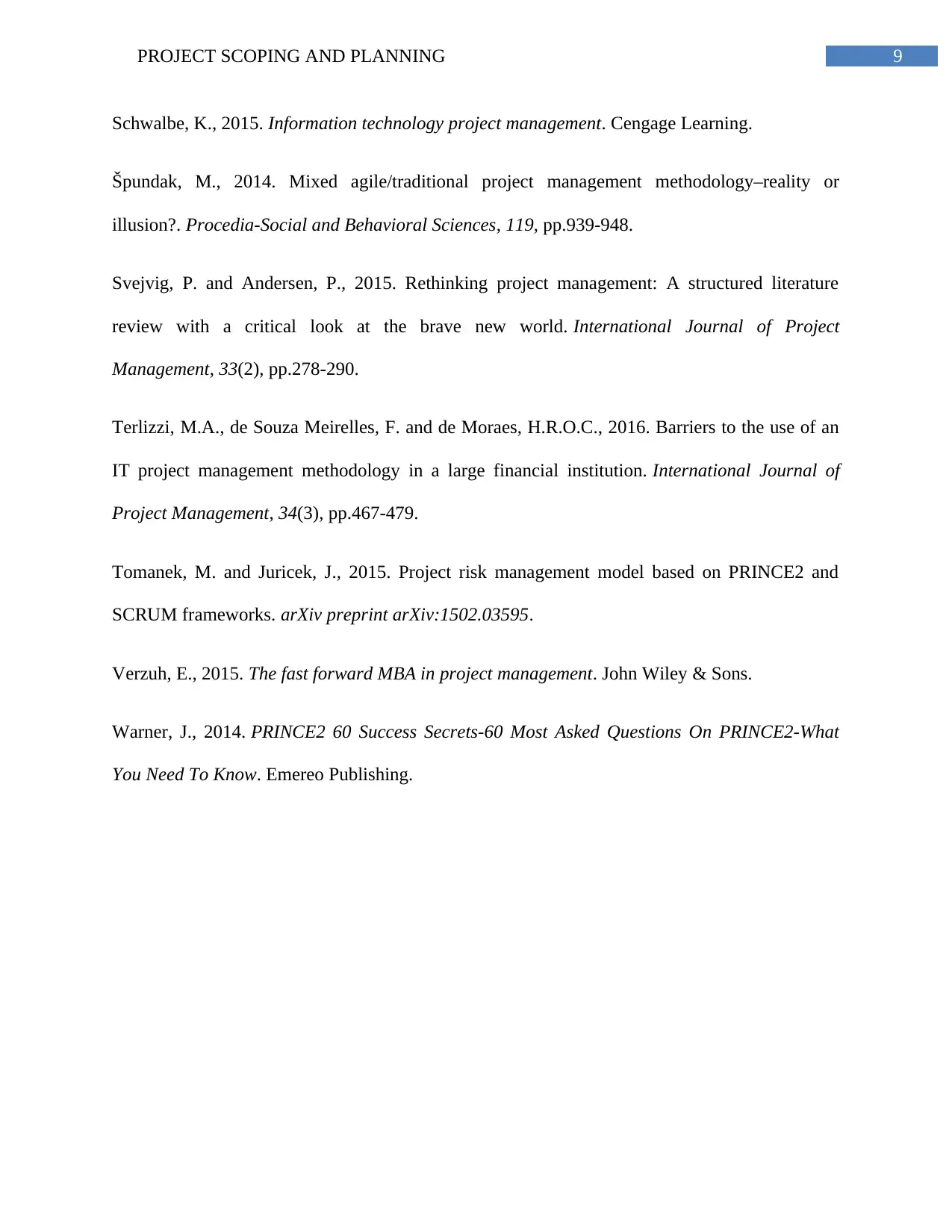
9PROJECT SCOPING AND PLANNING
Schwalbe, K., 2015. Information technology project management. Cengage Learning.
Špundak, M., 2014. Mixed agile/traditional project management methodology–reality or
illusion?. Procedia-Social and Behavioral Sciences, 119, pp.939-948.
Svejvig, P. and Andersen, P., 2015. Rethinking project management: A structured literature
review with a critical look at the brave new world. International Journal of Project
Management, 33(2), pp.278-290.
Terlizzi, M.A., de Souza Meirelles, F. and de Moraes, H.R.O.C., 2016. Barriers to the use of an
IT project management methodology in a large financial institution. International Journal of
Project Management, 34(3), pp.467-479.
Tomanek, M. and Juricek, J., 2015. Project risk management model based on PRINCE2 and
SCRUM frameworks. arXiv preprint arXiv:1502.03595.
Verzuh, E., 2015. The fast forward MBA in project management. John Wiley & Sons.
Warner, J., 2014. PRINCE2 60 Success Secrets-60 Most Asked Questions On PRINCE2-What
You Need To Know. Emereo Publishing.
Schwalbe, K., 2015. Information technology project management. Cengage Learning.
Špundak, M., 2014. Mixed agile/traditional project management methodology–reality or
illusion?. Procedia-Social and Behavioral Sciences, 119, pp.939-948.
Svejvig, P. and Andersen, P., 2015. Rethinking project management: A structured literature
review with a critical look at the brave new world. International Journal of Project
Management, 33(2), pp.278-290.
Terlizzi, M.A., de Souza Meirelles, F. and de Moraes, H.R.O.C., 2016. Barriers to the use of an
IT project management methodology in a large financial institution. International Journal of
Project Management, 34(3), pp.467-479.
Tomanek, M. and Juricek, J., 2015. Project risk management model based on PRINCE2 and
SCRUM frameworks. arXiv preprint arXiv:1502.03595.
Verzuh, E., 2015. The fast forward MBA in project management. John Wiley & Sons.
Warner, J., 2014. PRINCE2 60 Success Secrets-60 Most Asked Questions On PRINCE2-What
You Need To Know. Emereo Publishing.
1 out of 10
Related Documents
Your All-in-One AI-Powered Toolkit for Academic Success.
+13062052269
info@desklib.com
Available 24*7 on WhatsApp / Email
![[object Object]](/_next/static/media/star-bottom.7253800d.svg)
Unlock your academic potential
Copyright © 2020–2025 A2Z Services. All Rights Reserved. Developed and managed by ZUCOL.





